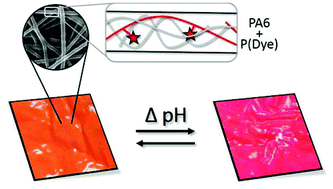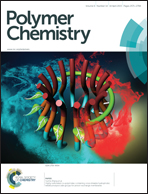Dye immobilization in halochromic nanofibers through blend electrospinning of a dye-containing copolymer and polyamide-6†
Abstract
‘Smart’ materials can be defined as materials that respond to a certain stimulus with a change in their properties. A specific class herein is halochromic textiles, i.e. fibrous materials that change color with pH. Such halochromic textiles play an important role in the continuous monitoring and visual reporting of the pH with applications in various fields, such as wound treatment and protective clothing. pH-sensitive nanofibrous nonwovens have high sensitivity and a fast response time, and are mostly fabricated by introducing a pH-responsive dye via dye-doping of the feed mixture before fabrication. However, this method suffers from leaching of the dye, which is an undesirable effect that not only reduces the output signal strength but can also be detrimental to the environment by causing, for instance, toxicological responses. In this paper, a new strategy is demonstrated for the reduction of dye leaching in electrospun, nanofibrous materials. Through blend electrospinning of polyamide-6 (PA6) with a dye-functionalized copolymer, large sheets of uniform, halochromic nanofibrous material can be fabricated showing a fast pH-sensitive color change. Polymeric entanglements within the nanofiber are proposed to immobilize the dye-functionalized copolymer in the PA6 matrix, resulting in drastically reduced dye leaching. Such stable nanofibrous, PA6-based, halochromic materials are particularly interesting in the design of new colorimetric sensors applicable in several sectors, including the biomedical field, agriculture, safety and technical textiles.


 Please wait while we load your content...
Please wait while we load your content...